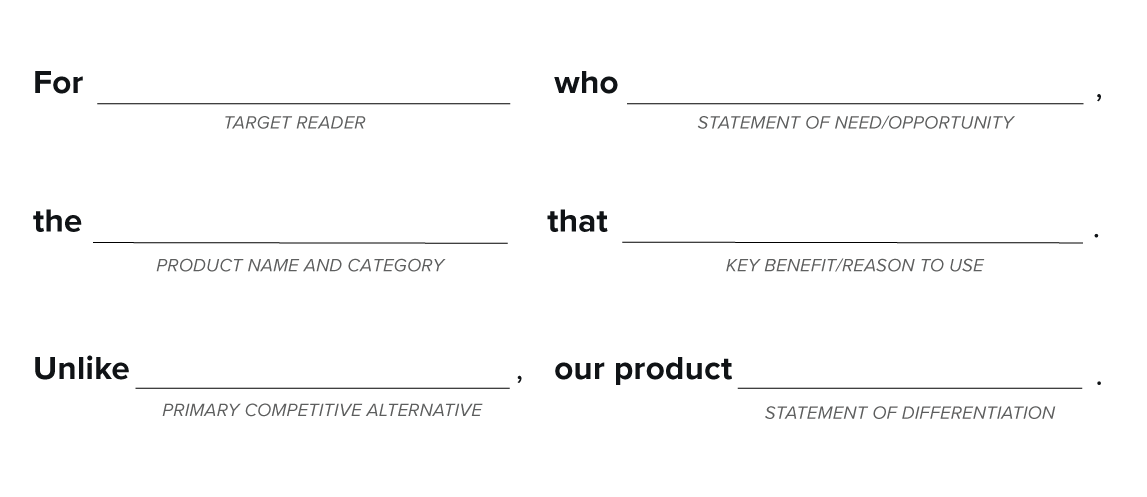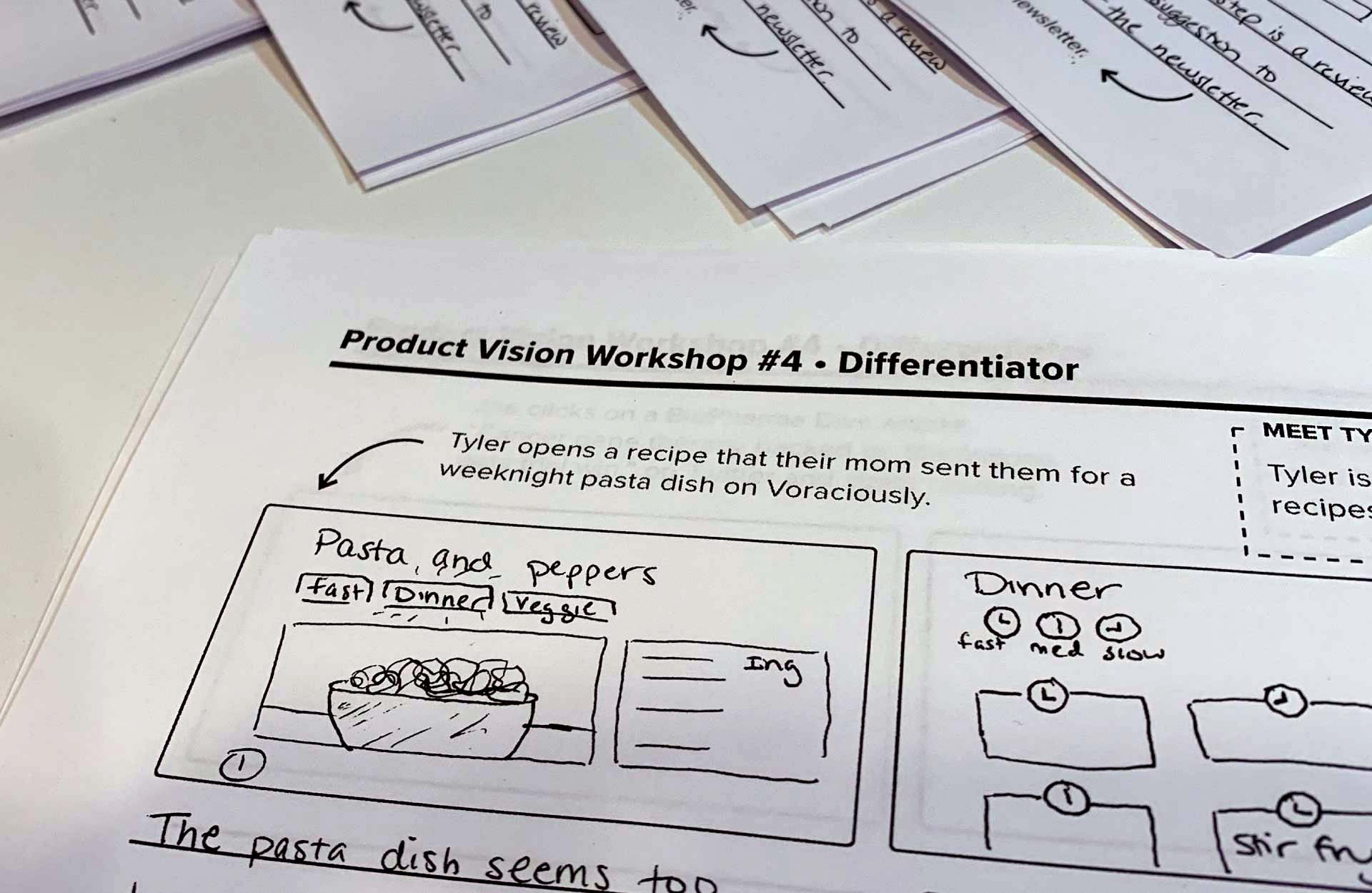4 workshop exercises to facilitate defining a product vision
Brainstorming activities, storyboard creation and persona interviews
UX Research| Posted April 17, 2020

A product vision explains why your product exists and where it is headed. This vision encourages collaboration between departments and creates buyin. It also helps product managers and stakeholders strategically prioritize features for their roadmap. While the concept of a product vision seems simple, actually writing one to accurately encompass all that your product has to offer can be intimidating.
In Geoffrey Moore’s book Crossing the Chasm, he suggests a template to help define a product vision succinctly and effectively.

While this template makes defining a product vision approachable, knowing your users, their needs and the product’s value proposition isn’t an easy task. Here are four exercises I used at Industry Dive, in collaboration with product designer Jordan Branch, to define our product vision.
I have included the worksheets we used for these exercises. Our workshops consisted of 6-8 departments executives and were tailored for a media publication site. The worksheets should be edited to reflect your stakeholders and product.
All of these exercises were conducted at the beginning of the year. If you are practicing social distancing, these exercises can be done virtually using a shared design board and video chat.
1. Working product vision statement
Staring at a blank product vision statement can be daunting. To help kickstart the conversation and introduce the concept of a product vision to the entire group, we used a brainstorming exercise with dot voting to create a working draft. The following workshops refined this statement.

Goal:
Create consensus around a working product vision statement to return to during stakeholder discussions.
Materials:
- Vision statement worksheet
- Sticky notes
- Sharpies
- Dot stickers
- White board and markers
Steps:
- Intro: Explain the purpose of a product vision statement. Refer to a product vision statement written on a whiteboard with corresponding blanks.
- Ideate: Give every participant a worksheet with the blank statement and six sticky notes. Using the sticky notes, have each participant fill in their statement.
- Present: Have each participant present their statement and add their stickies to the board in the corresponding blank.
- Initial vote: Using dot stickers, ask the participants to vote for one sticky in each blank that they think fits best.
- Discussion: Provide time for the group to discuss what they voted on and why. This is the time to remove stickies that are not of interest or rewrite ones that seem popular.
- Consensus voting: Have the group vote again, go through and discuss the final results and fill in each blank. This is a working statement and will be iterated on in other sessions.
Resources:
- Dot Voting: A Simple Decision-Making and Prioritizing Technique in UX by Sarah Gibbons, Nielsen Norman Group
- Crossing the Chasm by Geoffrey Moore
2. Persona interviews
To check assumptions made in the working product vision statement and develop empathy with our users, we conducted user interviews. These interviews informed personas that we referred to throughout our workshops.

Goal:
Create user personas to encourage empathy for the user during stakeholder discussions.
Materials:
- Clients or experts to interview
- Interview worksheets
- Persona posters
- Pens and markers
Steps:
- Intro: Explain the value of personas and knowing your users and their needs.
- Introductions: Introduce the users you have brought in for the stakeholders to interview.
- Interviews: Provide each stakeholder with a list of questions to ask the users. They should take notes as they learn the answers. (Note: We predefined the interview questions as not all stakeholders are experienced in conducting interviews.)
- Create personas: Using the interviews, have the participants fill out the persona poster for their user. The persona should emphasize habits, challenges and needs.
- Present personas: Have the stakeholders present their persona. These posters will then be hung up around the room for future discussions.
Resources:
- Google Ventures Design Sprint by Jake Knapp
- Empathy Mapping by Atlassian
- Empathy Mapping from UX Frameworks by Allison Grayce
3. Elevator pitch descriptors
A product vision statement summarizes your offering, but it can be easy to forget what sets your product apart. Elevator pitches require you to summarize what makes your product valuable in a short and direct way.

Goal:
Ideate on your product’s defining qualities and decide on a differentiator.
Materials:
- Elevator pitch worksheet
- Sticky notes
- Whiteboard and markers
Steps:
- Intro: Explain what an elevator pitch is and why you are using it.
- Brainstorm: Have the participants write an elevator pitch for your product.
- Pitch and listen: While each participant shares their elevator pitch, ask the audience to write down descriptors the presenter uses to describe the product.
- Share descriptors: Once everyone has shared, the participants should yell out the different descriptors they heard in the presentations. Write them all on the white board.
- Vote: Have the participants go up to the board and vote for three descriptors they think best represents the product.
- Discuss: Discuss the results and why the participants selected different options.
- Consensus voting: The group now votes again, go through and discuss the final results.
Resources:
- Elevator Pitch by Atlassian
- Dot Voting: A Simple Decision-Making and Prioritizing Technique in UX by Sarah Gibbons, Nielsen Norman Group
4. Aspirational storyboards
With the team boughtin on your user’s needs and product differentiator, the final question is determining how. Listening to stakeholder visions for the product is a good place to start. Storyboards allow participants to chronologically visualize how users might use your product. These creative scenarios uncover aspirational ideas for the product’s future.

Goal:
Create stakeholder storyboards to ideate on your product’s path forward.
Materials:
- Storyboard worksheet
- Pens and markers
Steps:
- Intro: Explain that you want to see what they envision for the product and there are no wrong answers. Presenting an example storyboard can be helpful as this is a new concept for many. Make sure to encourage the participants to be aspirational.
- Storyboarding: Give each participant a storyboard worksheet and provide plenty of time to fill it out. If a participant is hesitant to draw, suggest they start by writing the story and then going back and adding sketches.
- Presenting: Have each participant present their aspirational storyboard. Tell your participants that they will be asked to reflect on the presentations and can take notes if they like.
- Takeaways: On the back of their worksheet, have the participant’s write down their favorite feature from the presentations. These can help guide discussions in the future for product milestones.
Resources:
- Storyboards Help Visualize UX Ideas by Rachel Krause, Nielsen Norman Group
- The Value of UX Storyboarding for Product Design by Nick Babich, Shopify
Hopefully these exercises help your team create a product vision that you can build on with product milestones and effective KPIs.